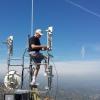The testing of the new UI continues, with a steadily-slowing stream of small fixes and enhancements moving into the code base for the next production release. That'll be sometime this month, hopefully.
As of this writing, over 30% of the nodes reachable via the World Map are running a nightly build that includes the new UI. No telling if the owner is using the new UI or not. (If you're running a nightly build and haven't updated recently it's probably time to do so and pick up a handful of those useful tweaks and small fixes).
Speaking of UIs, the next production release will continue to contain both legacy and new UIs, but the first nightly build after that will drop the legacy UI.
Issue reporting
Questions can go on social media or any of the forums. But if you think you've found a bug, the best place to post about it is in the appropriate GitHub instance.
For AREDN software: https://github.com/aredn/aredn/issues
For AREDN documentation: https://github.com/aredn/documentation/issues
And newly-created, for World Map issues: https://github.com/aredn/worldmap
Operational tips
Recently we had an issue where several nodes weren't showing up on the World Map. From the keyboard of the dev: "A valid node name is not just a call sign; it must be of the form CALLSIGN-SOMETHING for the map to pick it up. The new UI enforces this node naming convention for the first time, but doesn't force you to update the names of older nodes." That SOMETHING could simply be LOCATION. Radio-related data is now in the new UI (if you haven't filled it out - why not?) You may not have noticed it but if the azimuth of the node has been filled out, its pin on the World Map will point in that direction :-) Also the "Elevation" information is the degrees the antenna is pointing up or down from horizontal, negative or positive. Height is height above local ground.
General Info
If you've been wondering - the World Map scans the supernode network at 2 a.m., 8 a.m., 2 p.m., and 8 p.m. Pacific. Currently scans take about 12 minutes for approximately 2300 nodes.

